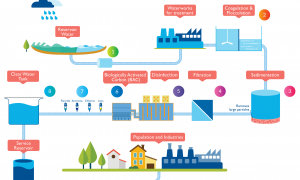🕑 Reading time: 1 minute
Contents:
Mean Precipitation Calculation Over an Area
Raingauge – does point sampling of the areal distribution of a storm Hydrological Analysis – requires information on rainfall over an area, say, over a catchment Methods used to convert point rainfall values at different raingauge stations into an average value over a catchment include- Arithmetical Mean Method
- Thiessen Polygon Method
- Isohyetal Method etc
Arithmetical Mean Method

Thiessen Polygon Method
Rainfall recorded at each station is given a weightage based on the area closest to the station Consider a catchment area with say, 3 raingauge stations. Let there be 3 stations outside the catchment, but in its neighborhood. The catchment area is drawn to scale and the position of these 6 stations are plotted on it. These 6 stations are joined so as to get a network of triangles. Perpendicular bisectors are drawn to each of the sides of these triangles. These bisectors form a polygon around each station. If the boundary of the catchment cuts the bisectors, then the boundary is taken as the outer limit of the polygon. These bounding polygons are called Thiessen Polygons. The area of these polygons is measured with a planimeter or by grid overlay. This method is considered superior to the arithmetical averaging method since some weightage is assigned to each raingauge station.
Even raingauge stations located outside the catchment are used in computing mean precipitation
This method is considered superior to the arithmetical averaging method since some weightage is assigned to each raingauge station.
Even raingauge stations located outside the catchment are used in computing mean precipitation

Figure: Thiessen Polygon
Isohyetal Method
- Isohyet – It is a line joining points of equal rainfall magnitude
- The catchment area is drawn to scale and the raingauge stations are marked on it
- The recorded rainfall values for which areal average is to determined are marked at the respective stations
- Neighbouring stations outside the catchment are also considered
- Taking point rainfall values as the guide, isohyets of different rainfall values are drawn (similar to drawing contours based on spot levels)

Figure: Isohyets of a storm
The area between adjacent isohyets is measured using a planimeter.- If isohyets go out of the catchment, the catchment boundary is used as the bounding line. It is assumed that the average value of rainfall indicated by two isohyets acts over the inter isohyetal area
- This method is considered superior to the previous methods when the number of raingauge stations are large



